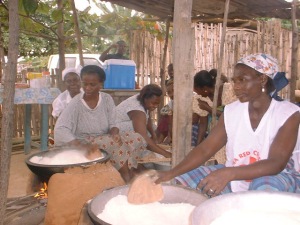| |
 |
|
The shredded cassava must next have its water content reduced.
This is done by squeezing a sack of shredded cassava between branches which
are held in tension by ropes. The ropes are gradually tightened as the water
is squeezed out. This takes 2 days. A mechanical press would do this more
efficiently (1 day), but costs about £500, something which the Mothers'
Club cannot afford. A useful donation by any individual, group or organisation
seeking to make a practical contribution? |
|
| |
|
|
|
|
| |
After squeezing out excess water, the cassava is sieved to remove any
remaining skin and husk. |
|
 |
|
| |
|
|
|
|
| |
 |
|
The resulting powdered cassava is now 'fried', that is, heated on large
metal pans over a wood fire. The pans rest on mud walls shaped into a horseshoe
form. |
|
| |
|
|
|
|
| |
The wood fire produced considerable smoke. This affects the health of
the workers, particularly their eyes. The cutting of the wood for the
fires also contributes to deforestation.
The process could be done more efficiently, and with less affect on the
mothers' health, if a gas oven were to be used. However, the cost is beyond
the reach of the Mothers' Club.
|
|
 |
|
| |
|
|
|
|
| |
 |
|
The product, called 'garee' is placed in bags, which are taken for sale
in the market. Garee is mixed with sugar and milk (or water) to make a form
of gruel high in carbohydrate. Its sale brings much-needed income to the
Mothers' Club. |
|
| |
|
|
|
|
| |
|
|
|
|
| |
The point of it all? Go to next stage |
|
|
|
| |
|
|
|
|




